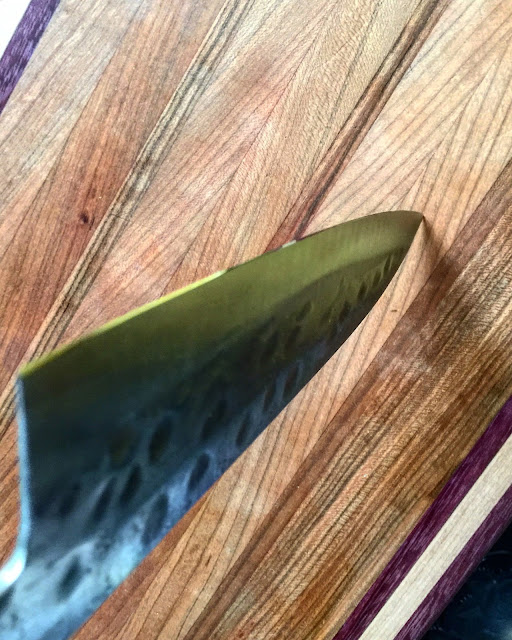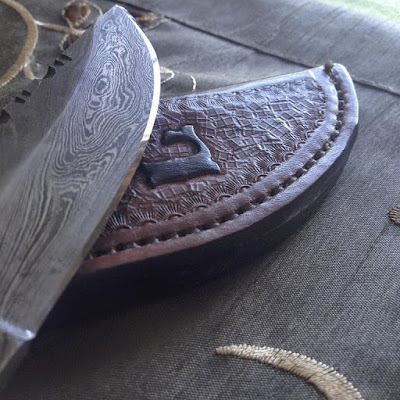Over the decades I have spent sharpening, and it is still a learning/perfecting process, I have picked up a few things that I can share for those interested. It is very likely that others have learnt the same things and what I am going to share is applicable to freehand sharpening and the Edge Pro.
I am extremely steadfast on one point, we should never stop learning. There are forums out there where I get the impression that certain people regard themselves as having reached a point where they are the fountain of knowledge because there is nothing left about sharpening for them to learn.
Also, I believe all sharpeners, regardless of their skill level can share information, often, the questions asked by a Newbie generate a lot of great answers that we can all benefit from. This is applicable to all facts of life, not just sharpening of course. The Captain of a naval ship relies on his crew to keep the ship moving, do defend it, to fire weapons, to rescue folks, to put out fires and deal with floods for example, it is often the lowly Able Seaman doing much of these things, the Captain, a good one, relies on his people. So we don't always know everything, we still have to be a bit of sponge and absorb things.
Now what I absorb these days will be different than someone getting started of course but the point is, I'm still open to learning and you should be as well. I have this before and I will say it again, even Master Knife Sharpeners can become better Master Sharpeners.
So I got that off my chest, thanks for sticking around :)
Here are some random things and as I think of more tidbits I will keep this updated with a new Blog Post and a link to this one.
These are not in order of importance, they are in the order that they come to me as I sit here and write, I will forget some but as I said, I'll add them.
ONE: MIRROR FINISHES
One of the rites of passage of a serious knife sharpener is the creation of mirror like bevels
Well, I'm over myself now and not fixated on this element of knife sharpening but I do appreciate the fact that folks can demonstrate a lot of patience with this. Many of my customers ask for this and I make sure to tell them that it is not an indication of sharpness but heck, there is no denying that it is pretty cool and in most cases, the knives are quite sharp, if a fella/girl can do this, they know how to make the knife sharp.
First of all, you don't need an Edge Pro or Wicked Edge to make this happen although I will admit that it is easier and in most cases a nicer polish due to the level of precision. In the picture above the knife on the right I did by hand and the one on the left by the EP. ( I think so, it was a year ago so I may that mixed up, the point is that you can do this by hand)
You do need a nice bunch of stones though and the higher the grit the better but if you only have three stones, you can still do it, it depends on the grit so a 5k at least to finish. I am sure that there are folks who can do this with a 2k stone, I have a nice 4k Imanishi stone that puts an exceptional polish on the bevels/edge.
The key is patience and for me, a lot of water. If I start with a 400 grit stone or say the 220 EP Stone I spend a lot of time ensuring that the scratch pattern on the bevels is as even as possible so I check that with a loupe. I am constantly applying water to the stones and to the knife. ( I dip my blades in water as I sharpen, not just "mirror sharpening" but all sharpening). You can also place a drop of dish water detergent on the stone as you work. Remember, patience, and a good knowledge of how to manipulate pressure. Pretend that the only stone you have is that first one so you get those bevels as polished as you can with that 400 stone or 220 and you do this by using ever decreasing amounts of pressure. With the EP you are almost lifting the Stone Arm off the knife, that is how light you should be working at the end of the polishing stage. Scratches in the bevels must be reduced in depth as much as possible prior to proceeding to that 1k stone that you are dying to use.
Once you are satisfied, or sick of that first stone than switch to the next grit. If you have 5 stones, use them all, your goal is to reduce the scratches in the bevels with the stones so if you went from a 400 to a 5k for example, you will need to spend a serious amount of time on those bevels and I have never done that. So I don't know if you can even do a mirror bevel like that.
Just keep at it and adjust the pressure so that with each stone you are barely touching the bevels and edge with the stone and keep it well lubricated, you don't want to contaminate the area that you are working so hard on with bits of grit.
Once you get to the 3k level you will see your hard work starting to show and if you have a Naniwa Chosera 3k you are going to be quite pleased that you do own one.
I don't mind sharing my pictures as long as folks don't think this is a benchmark that has to be met and in all honesty there are very likely sharpeners out there that can put me to shame, I know there are, I love those guys :)
So....Lot's of water, lot's of patience and an ability to manipulate pressure. Also and understanding that you need to reduce the depth of the scratches in the bevels, the more you do that the more shiny it looks until it becomes like mercury.
If you are using the EP use every stone in your arsenal, and if the 1k is the highest grit ( Ben does have a 1200 stone) then you are going to have to be patient. Of course you will probably have the Polishing Tapes as well to assist you.
I hope this helps, and again, as I think of things I will add them. I tend to ramble on so this was longer than I thought it would be but I know people enjoy pictures.
Peter











No comments:
Post a Comment